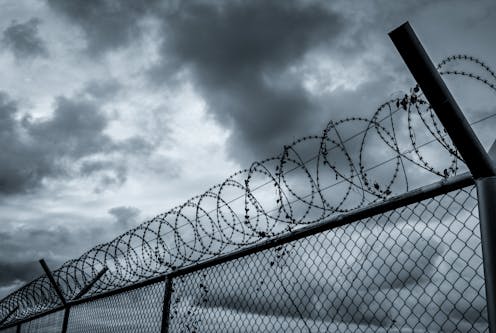
In 2008, Australia agreed to six targets to “close the gap” – to reduce the disparities between Indigenous people and the rest of the population in health, education and employment.
There was little progress in the years following, and it was agreed that, if Indigenous people’s health was to improve and children were to fare better at school, other inter-related aspects of life – such as incarceration rates, housing, and social and emotional wellbeing – also needed to improve.
So, in 2020, several additional targets addressing socioeconomic equity were included, making 19 in total. Each year, the Productivity Commission reports on whether these Closing the Gap targets are on track, or not.
The most recent report, out this week, finds few of the targets are on track, and some are worsening. One of those going backwards is incarceration.
What does the data show?
The Closing the Gap target pertaining to criminal justice is that by 2031, we reduce the rate of Indigenous adults in prison by at least 15%.
This new report uses data on incarceration up to June 30, 2023, and compares it with 2019, the “baseline” year.
To quantify incarceration, the basic measure used in this report is the total number of people in prison in each state and territory as well as added together for a national figure, translated into a rate per 100,000.
The rate of Indigenous prisoners in 2023 was 2,266 per 100,000 compared to 2,143 per 100,000 in 2019. This is compared with non-Indigenous Australians’ incarceration rate of 149 per 100,000 in 2023 which has been steady or decreasing since 2019.
If we go back to 2009 the rate of Indigenous incarceration was 1,539 in every 100,000.
So rather than incarceration rates decreasing towards the Closing the Gap target, they’ve increased over time, and Indigenous people continue to be grossly over-represented in Australian prisons.
Separate figures indicate Indigenous men are 17 times more likely and Indigenous women are 25 times more likely to be incarcerated than non-Indigenous men and women respectively.
Youth justice is little better
The youth justice Closing the Gap target is that by 2031, we reduce the rate of Indigenous young people (10–17 years) in detention by at least 30%.
The Productivity Commission measures progress on this target by the number of young people aged 10–17 in detention on an average day per 10,000 (though it’s presented in the graph below per 100,000).
The 2022–23 rate – just under 30 per 10,000 Indigenous children and young people in detention – is a small decrease from 32 per 10,000 in 2018–19 (the baseline year). But it’s above the previous three years (from a low of 24 per 10,000 in 2020–21).
On this basis, the Productivity Commission report has assessed this target as unchanged from baseline.
Meanwhile, the rate of non-Indigenous young people in detention was just one per 10,000 in 2022–23. So like Indigenous adults, Indigenous young people continue to be disproportionately represented in juvenile justice systems.
Why is this happening?
We know these disparities are not only, or even primarily, about criminal justice. The social determinants of health and justice tell us there are a variety of factors that put Indigenous children and adults onto criminal justice conveyor belts in these large numbers. These include:
spending time in out-of-home care as a child
having contact with the police early in life
being a victim of violence and abuse
experiencing poverty
having poor or no safe housing
poor school education
having a mental health disorder or cognitive disability, and not receiving adequate support
early introduction to alcohol and other drugs
experiencing racism or discrimination.
The more of these factors a person experiences, the worse their health and social outcomes are likely to be and the more likely they are to end up in prison. And all of these factors are more likely to affect an Indigenous Australian compared to a non-Indigenous Australian.
Taking a couple of examples from this list can show us how strongly these factors correlate with incarceration. The new report indicates around 43% of Indigenous adults who entered prison in 2022 had been told they had a mental health disorder at some stage in their lives.
Some 71% of of Indigenous people entering prison in 2022 reported they had used an illicit substance within the previous 12 months.
Similarly, when we look at Indigenous people in prison, a higher proportion than in the general population, or in the broader prison population, has cognitive and other disabilities.
All these three factors are experienced at higher rates among First Nations prisoners than non-Indigenous prisoners and the general population, according to the Australian Law Reform Commission and the disability royal commission.
Research I conducted with colleagues – which included quantitative data and interviewing Indigenous people who had been incarcerated, Elders and service providers in communities – indicated that upwards of 90% of Indigenous prisoners in New South Wales have complex health and disability support needs.
These findings have been confirmed by the Australian Institute of Health and Welfare, with the data showing most First Nations prisoners have one or more issues related to mental health, disability, trauma from violence and abuse, and drug and alcohol issues.
What next?
It’s a national disgrace that incarceration rates for Indigenous people are going up rather than down, particularly when it means many people with the most complex health and disability needs are being locked up.
Inspectors of prisons, children’s commissioners, the disability royal commission, Aboriginal legal services, legal aid and Aboriginal community-controlled organisations across Australia are urging governments to address poverty and disadvantage, improve education opportunities, stop the police being the frontline service for mental health and disability matters, and listen to and act on First Nations community knowledge and insight.
Eileen Baldry receives funding from the Australian Research Council and the National Health and Medical Research Council.
This article was originally published on The Conversation. Read the original article.







